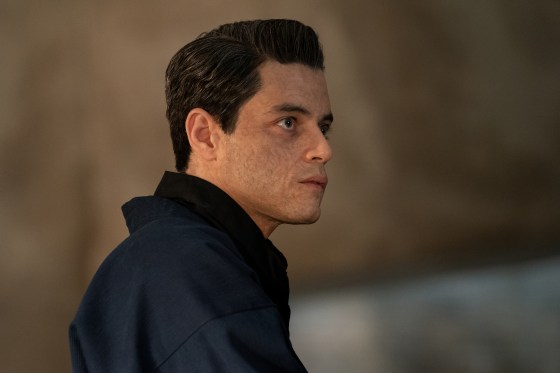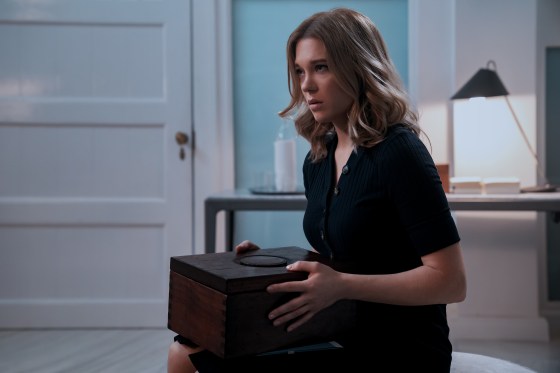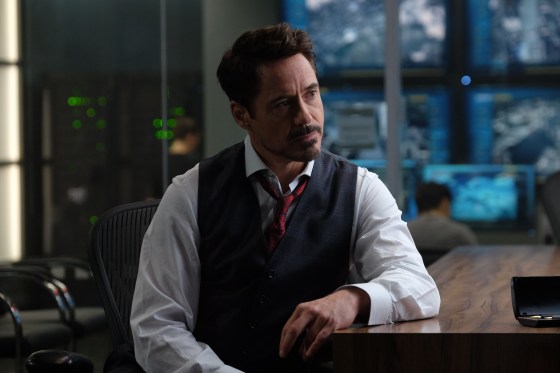New story in Entertainment from Time: How No Time to Die’s Unprecedented Ending Sets Up the Future of the Bond Franchise
Warning: Major spoilers for No Time to Die ahead.
Bond is dead. Long live James Bond.
In the franchise’s storied 58-year history, 007 has never actually died. Bond movies usually end with the successful destruction of a villain’s lair, and the camera panning away as the hero beds a Bond girl—on a boat, in space, on a balcony, often with his would-be rescuers looking on. The next movie may star the same actor or a different one, but rarely does anything of real consequence—romances, villainous encounters—carry over from film to film. Even when Bond’s wife was murdered on their wedding day in On Her Majesty’s Secret Service (1969), she’s never even mentioned in the film’s sequel, Diamonds Are Forever (1971). Even when Bond hunts down Blofeld, the man he presumably holds responsible for his wife’s death, he never even mentions Tracy’s name.
[time-brightcove not-tgx=”true”]
That refusal to establish Bond film continuity changed in a big way with Casino Royale (2006), the first to star Daniel Craig in its title role. That film ends with the revelation that Bond’s first true love, Vesper, was being blackmailed by a villainous figure. At their behest, she worked to entrap Bond but later sacrificed her life in order to save his. In the final scene of Casino Royale, Bond begins his journey to discovering the man responsible for Vesper’s betrayal and death, and subsequent movies follow him down the rabbit hole of exposing the evil organization Spectre and its leader, Ernst Blofeld (Christoph Waltz). In 2015’s Spectre, 007 finally finds Blofeld and learns that this man was in fact the “architect” of all of Bond’s pain throughout the entire movie series. Everything is connected, alas.
And so No Time to Die, released in theaters Oct. 8, endeavors to bring this arc to a close with an actual finale. And, despite the movie’s title, James Bond—as played by Craig in his last outing as the famous spy—does, in fact, die. Here’s why 007 had to sacrifice himself and what it means for the future of the franchise.
Read More: No Time to Die Is an Imperfect Movie. But It’s a Perfect Finale for the Best James Bond Ever
How James Bond dies

The path to Bond’s demise starts with the movie’s first major twist, another departure for the famously unattached spy. Halfway through the film, Bond discovers that he has a daughter. It’s a first for any 007.
At the beginning of the movie, Bond finds himself deeply in love with Madeleine Swann (Léa Seydoux), whom he met during the events of Spectre. Swann says that in order for the two of them to have a future together, Bond needs to let go of the memory of Vesper. Bond visits Vesper’s grave in Italy, only for the tomb to explode in an attempted assassination by Spectre goons.
Bond, of course, escapes the explosion relatively unscathed only to be greeted by the aforementioned goons. During a fight scene, one such thug insinuates that Madeleine betrayed him—just like Vesper had. A wounded Bond kills the bad guys and puts Madeleine on a train, planning to never see her again. He then heads to a remote island to live out his retirement in teeny, tiny swim trunks.
Five years later, Bond is dragged back into the spy game and collides with none other than Madeleine, who is now working as a therapist for MI6. And, surprise! She has a daughter. (MI6 apparently did not know about this child, which makes one seriously question the abilities of the Brits to gather intelligence. A dozen megalomaniacs have vendettas against Bond at this point. Maybe they should keep better track of his possible offspring, who would be obvious targets for kidnapping?)
Madeleine claims the child is not Bond’s. It’s a pretty obvious lie. As Bond points out, they share the same intense blue eyes. Madeleine will, of course, later in the movie confess that his suspicions are well-founded. Predictably, the movie’s villain, Safin (Rami Malek) kidnaps Madeleine and the child and takes them to his lair, an island where he harvests a bunch of different poisons because, well, he’s a creepy Bond villain.
Safin is mass-producing a bioweapon, a poison that is programmed to people’s specific DNA. If the targeted person is exposed to that poison, they will die, even though the carrier of the toxin will remain unharmed. He wants to use the poisons to target specific people and throw the world into chaos for vague bad-guy reasons.
With the help of another 00 agent, Nomi (Lashana Lynch), Bond gets Madeleine and their daughter off the island. Bond stays behind to open a bunch of missile silos so that the Brits can blow the place to smithereens, only to encounter Safin on his way out. Safin poisons Bond with a toxin that will specifically kill Madeleine and their daughter if Bond goes anywhere near them, which means Bond can never touch his love or child ever again. Tech genius Q (Ben Whishaw) tells Bond that there’s no way to remove the toxin once it’s been applied. How he can possibly know this—and whether some experimentation over the course of years could lead to a cure—is unclear, but Bond accepts this fate quickly.
Bond shoots Safin dead, and then calls Madeleine to wish her farewell as he watches several missiles approach the island. And then, boom, Bond is gone. Whether you’re a fan of Daniel Craig’s portrayal of Bond or not, it’s a rather poetic ending to the era. The five films that starred him successfully pivoted the franchise from one-off romps filled with fast cars, cool gadgets and, yes, the Bond woman, to a brutal epic of a hitman trying to find his soul.
But Bond’s death was also necessary for this franchise to survive.
Was a permanent end necessary to let Daniel Craig finally bow out?

It’s no secret that Daniel Craig has wanted out from the Bond franchise for awhile now. He infamously declared in 2015 he’d rather “slash his wrists” than return the character and quipped that if he did come back it would only be for money. He did, of course, end up coming back for one more outing. One can’t help but speculate that he returned to the franchise on the condition that he be offed by the end of the film so a massive paycheck could never tempt him again.
He’s not the first actor to want out of an iconic role. Harrison Ford reportedly begged George Lucas to kill Han Solo before finally getting his wish at the hands of J.J. Abrams, decades later, in The Force Awakens. Leonard Nimoy reportedly wanted to kill off Spock in Wrath of Khan only to later change his mind. Even Sean Connery, the man who made James Bond an icon, wanted 007 dead after playing the character seven times (though he never got his wish). Onscreen deaths can not only offer an actor a reprieve from a role that offers diminishing creative returns, but a heroic and bittersweet demise can also engender sympathy for a character and cement their cinematic legacy.
Craig craved an identity beyond the Bond character. Thankfully, he has found it in other films, particularly as Detective Benoit Blanc in Knives Out, which is getting a whole series of movies on Netflix. Now, unless the Bond Cinematic Universe goes the way of superhero films and begins resurrecting characters using time travel, quantum mechanics and whatever other movie magic the writers can think up, he’ll be able to move on from Bond forever.
Bond’s sacrifice gives him a redemptive arc that modern audiences need

We all know that the character of James Bond is problematic. The character has a history of raping, objectifying and using women. And Bond movies often glamorized that behavior. The character taught generations of men that misogyny was cool. Just as little girls look to figures like Barbie to perceive what they should be, what they should value and how they should interact with men when they grow up, so too do little boys look for cues from famous, enduring figures like Bond.
To its credit, Casino Royale tried to reckon with the question of how, exactly, Bond became such a misogynist. A betrayal by a woman provided part of the answer, though misogyny seemed to be baked into Bond’s very character. Before Craig’s Bond ever meets Vesper, he sleeps with a woman for information and is hardly perturbed when he finds her brutally murdered the next day. By the end of the movie, when he finds out that Vesper both betrayed and saved him, he responds, infamously, “The bitch is dead.”
It’s hard to reconcile that brutal perspective with the fact that Bond remained eminently hip—a familiar vehicle through which tailors and car dealers and watchmakers could hawk their wares to an adoring public. The movie wanted us to acknowledge this man we idolized was a monster, but didn’t want us to stop idolizing him.
How, exactly, that character could survive a post-#MeToo era was unclear. Could the world’s most famous fictional misogynist endure? Would he have to reform?
Given the choice between reckoning with Bond’s past and ignoring it, No Time to Die—the first Bond movie filmed since #MeToo went viral in 2017—leans into the latter. Nomi, who bears the title of 007 herself for much of the film, occasionally quips that Bond is a dinosaur. But by the end of the movie, she cedes the 007 title to him as a sign of respect, seemingly offering her approval and erasing any of his past misdeeds.
How does Bond go from questionable womanizer to good guy so quickly? The answer lies squarely at the feet of his daughter. As soon as she enters the picture, the most brutal things Bond does, like dropping a car on a bad guy begging for his life, are not out of coldness but in service of this innocent. The audience automatically extends sympathy to a man just trying to defend his family. He is, to use a phrase that has been wielded (and mocked) widely in recent years, now the forever awakened father of a daughter.
This isn’t a new trick in Hollywood. Dads looking to protect, specifically, their young girls have been in vogue as of late: Just look at Taken, Stillwater, Sweet Girl and, in the closest parallel to the current Bond plot, Avengers: Endgame.
Read more: From Stillwater to Sweet Girl, A New Crop of Movies Explores the Plight of Modern Dads
Hollywood has a knack for redeeming womanizers

This redemption arc is a familiar one. Only two years after Casino Royale premiered, Iron Man debuted, launching the Marvel Cinematic Universe (MCU). The movie improbably starred the world’s biggest playboy as a superhero. Like Bond, Robert Downey Jr.’s Tony Stark engaged in some womanizing that has aged particularly poorly, including sleeping with a journalist that Stark’s assistant, Pepper Potts, deems “trash,” and ogling bikini pictures of Scarlett Johansson’s Black Widow, whom Pepper observes is “a very expensive potential sexual harassment suit.” (The fact that Gwyneth Paltrow as Pepper Potts had to utter both of these putdowns of fellow women is particularly gross.)
But by the time that (spoiler alert for Avengers: Endgame) Tony Stark sacrificed himself at the end of that saga, he was—you guessed it—the father of an adorable little girl, an all-around family man and unassailable hero. Both franchises had years to get with the times, to transform IP created for another era (Bond and Iron Man were conceived in 1953 and 1963, respectively) into the sorts of protagonists we can actually applaud today.
In fact, No Time to Die and Avengers: Endgame bear striking parallels. Bond and Stark are both anti-heroes who do questionable things for the sake of humanity, even if Bond puts a grimmer spin on his actions than the smirking Tony Stark. Each reforms, retires and seemingly finds his happily-ever-afters off the beaten path—Bond gleefully whispers “Je t’aime” to Madeleine as they tumble into bed at an Italian hotel together at the beginning of No Time to Die; Stark, meanwhile, feeds his daughter ice pops in the woods as they tell each other, “I love you 3000.”
A plea to return to the fray arrives from a friend, Felix Lighter in Bond’s case and Steve Rogers in Stark’s. Each agrees, in part because of guilt. (Stark gazes at a picture of the disappeared Peter Parker he failed to save, Bond tells Madeleine his greatest regret is putting her on that train.) After a touching scene with their mini-mes—Stark’s daughter dons the Iron Man helmet, while Bond’s daughter blinks up at him with his bright blue eyes—they sacrifice themselves for the greater good.
With that, the redemption arc that might win over even the most skeptical audience members is complete. And it offers a clean slate to whoever might come next.
Where does the Bond franchise go from here?

Does Bond’s death (and the fact that it so heavily evokes the sacrifice of a superhero) suggest that we’re about to get the Marvelization of Bond? That might seem antithetical to the franchise, which has always casually recast new actors to play the role without ever commenting on it in the film. Bond exists outside of time and space, never explicitly aging and always evolving to suit the needs of a new era.
The Craig era of Bond movies has strayed from that ethos a bit. This Bond did, indeed, grow old and now has met his demise. Many 007 fans booed Spectre exactly because it got so bogged down in the mythology of the franchise, tracing which old villains came from where and obsessing over the hero’s origin story rather than cool cards and well-cut suits. If Bond has gained gravity, even gained a soul, he’s lost the lightness of those first films. Until now, the Bond films could be watched in a vacuum or as part of a binge, and even the silliest ones satisfied because of just how ridiculous and disposable everything and everyone in them was, including not only the Bond girls but also the hero himself, subbed out every few years. In such a grim offscreen moment, fans would be forgiven for longing for that carefree version of the character.
But is Bond’s misogyny so coded into his DNA that it’s impossible to remake this character? Craig’s Bond bore women ill feelings, and the series reckoned with them only slightly before offering him a saving grace in the form of a daughter. Would another, lighter version simply make light of the fact that this character has existed in the public imagination as an chauvinist for all this time?
It’s hard to imagine it would. It wasn’t 007 slapping girls in the face that made those older Bond movies enjoyable. It was the lightness with which he handled even the most terrifying villain’s plots, meeting them with a quip and a swig of his martini.
The producers have said they won’t begin their hunt for the next Bond until next year. And though the introduction of Nomi suggested Lynch might inherit the role, producers and Craig have shut those rumors down. Craig recently said that he didn’t think Bond should be a woman. “Why should a woman play James Bond when there should be a part just as good as James Bond, but for a woman?”
While that might be the ideal circumstance, that suggestion ignores the fact that nobody (save, perhaps, Christopher Nolan) can seem to get an original idea greenlit in Hollywood these days. Studios are obsessed with IP and old, proven IP, especially in the domain of action and spy thrillers, simply does not exist for women. Searching for a history of female spies, all one can find is Charlie’s Angels, whose gender politics are so fraught to that story of three women at the beck and call of a mysterious man may be impossible to adapt well. The most promising female spy movie may in fact be a spinoff from the Bond franchise, perhaps one set in Cuba and starring Ana de Armas, the breakout star of No Time to Die (and Craig’s co-star in Knives Out).
But certainly, now that Craig has put his Bond to bed, the Broccoli family has an opportunity to signal to the world that they are rethinking this character, dragging him into the modern era if they must. They can reshape him or confront his past. But they cannot outrun his legacy.




Post a Comment